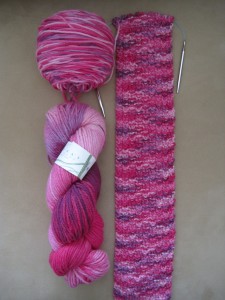
My daughter's scarf in progress. Here you can see what the variegated yarn looks like when it's in a hank, wound into a ball, and knitted up.
I just started knitting a scarf for my daughter using variegated yarn, and as I was winding up the hank I thought back to when I first began knitting and how I shied away from using variegated yarn because I could never envision what a ball or hank of multi-colored yarn would look like when knitted up.1 I still have trouble seeing in my head what the end result will be just by looking at the variegated hank, but over the last couple of years I have gained a general understanding of variegated yarn, and I am now a braver knitter, and willing to experiment.
As with learning many things in life, the best way I learned about knitting with variegated yarn was to just jump in and do it. I also found a book very helpful: The Knitter’s Guide to Hand-Dyed and Variegated Yarn by Lorna Miser (the Lorna of Lorna’s Laces). Of particular help to me was the section discussing types of variegated yarn (for example, yarns with short color repeats versus long repeats) and their pooling effects. The book may be of interest to you, too, if you haven’t used variegated yarn before and are trepidatious like I was.
With highly-variegated yarns2 I have found that scarves are a good option. I have made four scarves, using four different highly-variegated yarns, and they all were lovely. The first such scarf I finished was one made for my mom. She approved the yarn3 and I chose a basketweave pattern4 because I like to use reversible patterns for scarves since both sides are often visible. I was very pleased with the end result, as was my mom, and it encouraged me to keep trying variegated yarn.
- My mom’s basketweave scarf, knit with mercerized cotton.
- Another basketweave scarf, knit lengthwise with ruffled edges, in mercerized cotton.
- Universal Scarf (pattern by Vicki Square) knit with a cotton/acrylic/rayon blend.
- Another Universal Scarf, knit with baby alpaca.
- My daughter’s scarf in progress. Here you can see what the variegated yarn looks like when it’s in a hank, wound into a ball, and knitted up.
- Double Moss Stitch
This scarf for my daughter is my fifth using variegated yarn. The yarn is from my stash,5 having bought it many, many moons ago, not certain what I would do with it, but knowing it was the perfect mix of colors for my I-love-pink-and-purple little girl.
My daughter got a new dark purple winter jacket and I thought–aha!–I can use that pink and purple variegated yarn in my stash to make her a scarf and hat (and maybe even mittens if I get really industrious). Since the yarn has so much color, I wanted a simple pattern, and since it’s a scarf, I wanted something reversible and that would lay flat.
I did a small test swatch with the yarn, starting with garter stitch, then moving on to seed stitch, and I didn’t feel either showcased the yarn properly. The rows were too close together in garter stitch,6 and the seed stitch was too textured and “busy” for the color changes. Then I tried a variation on moss stitch (aka double seed stitch) and liked the result. I’ll call my variation double moss stitch because it’s two moss stitches set side-by-side. Double moss stitch has the texture and simplicity of seed stitch, but by having blocks of knit and purl stitches the changes in both color and texture are more gradual and better showcase the beautifully-hued yarn.
When I finish my daughter’s scarf, I’ll post the pattern, so check back if you’ve been wondering what to do with that one hank of beautiful, variegated yarn that you just had to buy but has been sitting in your stash, feeling unloved, for an eternity.
- Now that’s not to say that I didn’t buy variegated yarn–I love color, and there are so many beautiful color combinations out there in the yarn world–but it did take me a long time to find a potential project and to be brave enough to try using it. [↩]
- By “highly variegated” I mean yarns that have lots of different colors mixed together, not merely different tones of one color. [↩]
- It was in my stash–I told you I bought variegated yarn! [↩]
- My Basketweave Summery Scarf pattern is available for download under the “Patterns” page tab. [↩]
- The yarn is Lorna’s Laces Green Line Worsted in the colorway Tickled Pink. Green Line has been discontinued, but Lorna’s Laces Shepherd Worsted yarn would be a good substitute, and Tickled Pink is a current colorway in that yarn. [↩]
- And I didn’t want to go up a needle size because I wanted a dense, good-for-winter fabric [↩]

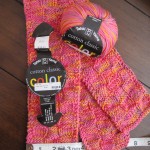
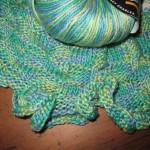
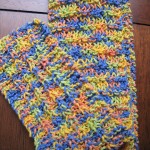
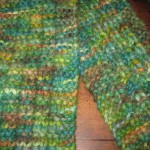
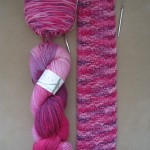
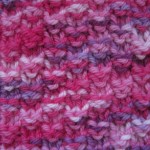
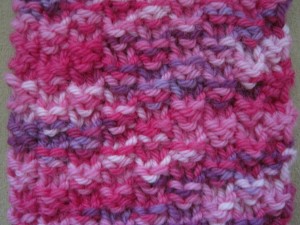
Pingback: Knitting a Scarf with Variegated Yarn | MakerKnit.com
How should the strands of yarn be run together to form a more tweed effect? No pooling desired.
One way to avoid pooling is to alternate yarn from two separate balls (or two ends from a single ball if your project only uses one ball of yarn). So you’d knit for a row or two with one ball, then switch to the other ball for the next row or two, then back to the first ball, etc. You can carry the yarn from the unused ball up the side, so it’s easy to alternate. How effective this method will be, and whether it will create a “tweed” effect, is dependent upon how long or short the repeats are in your particular yarn. If you’re really concerned about pooling, do some swatching and see how your yarn knits up, but make sure your swatch is at least two times as big as your yarn’s repeat and that when you alternate balls you start at a different section of the repeat. Good luck and happy knitting!